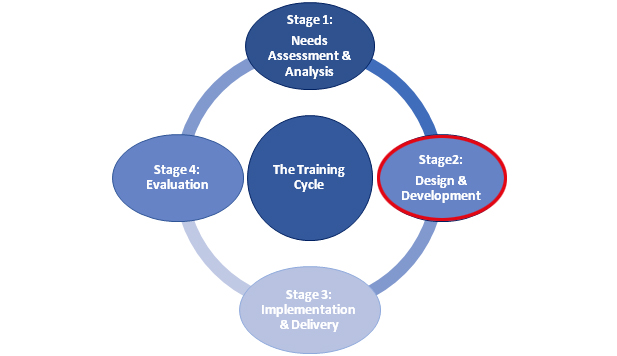In last month’s newsletter we started to examine each specific stage of the training cycle to understand the key considerations for an integrated and holistic approach to L&D. Following on from the March edition of the newsletter which focused on Stage 1 – ‘Needs Assessment & Analysis’, we will now discuss Stage 2 – ‘Design & Development’
As a reminder, the four stages of the training cycle are illustrated below:
Stage 2: Design and Development
Whether an organisation has the in-house capability to design and develop Learning & Development (L&D) interventions, or decides to outsource to a third party provider, the principles of design and development in the L&D context remain the same. During stage 2, it is important to focus on and ensure, that any L&D interventions are aligned with the outcomes of the TNA.
Designing L&D interventions can be compared to planning for a trip. Just as it is important to map out the best possible route to reach the final destination, it is important to map out the best methodology to design L&D interventions that will meet the objectives. Design can be seen as an outline of all the “what, where, who, when and how” details of a training intervention.
Here are some tips that should be considered when designing and developing L&D interventions:
Training evaluation – Before initiating the design and development of an L&D intervention, it is important to consider how this will be evaluated and what tools and techniques will be used to measure the effectiveness of the intervention.
Participant profile – The size of the target audience and their specific skills/ability level should be considered in the design and development phase to ensure that the learning tools and resources used are fit for purpose and the content is differentiated to suit the participants’ needs
Instructional strategies – Prior selection of instructional strategies adds substantial value to the effectiveness of the design. In making these selections, it is important to ensure that that the chosen instructional strategies meet the needs of the target audience. In recent years we have seen significant changes in L&D trends and in particular in delivery styles, where face to face lecture style training has now been replaced with more interactive, experiential learning and hands-on digitally driven tools.
Training logistics – Training logistics is an important aspect of the design and development phase which is often forgotten or left to the last minute. Early consideration to this aspect of the design and development of an L&D intervention can have a significant impact on the overall participant experience. Logistics need to be carefully planned to ensure the training environment is compatible with the training design, which contributes to maximizing engagement and the overall participant experience. Logistical considerations can include but are not limited to the following:
- Scheduling (courses & participants)
- Communication with participants (invites)
- Training structure & duration
- Days of the week/time of the day
- Duration of each session
- Location
- Training materials
- Resources & collaterals
- Cost/participant expenses
After considering the aspects listed above, the next step would be to develop a detailed session plan to organise the design in a structured manner. This helps to shape the design by planning out specific step by step actions of the training content and how this training will be delivered. A well written session plan can contribute significantly to ensuring that the training methodology and resources are aligned to the learning outcomes.
Designing the structure and content of an L&D intervention is a very detailed activity which can be very time consuming. In fact the design and development phase tends to be the most time consuming phase of the training cycle.
Design and development requires critical thinking and creativity. In today’s digitally connected world, content is readily available at a click of a button, and often free of charge so time spent in researching and using available content to create viable course designs can often be more worthwhile creating something from scratch. However it is important to remember to take consent prior to using content properly and referencing material/content where necessary.


